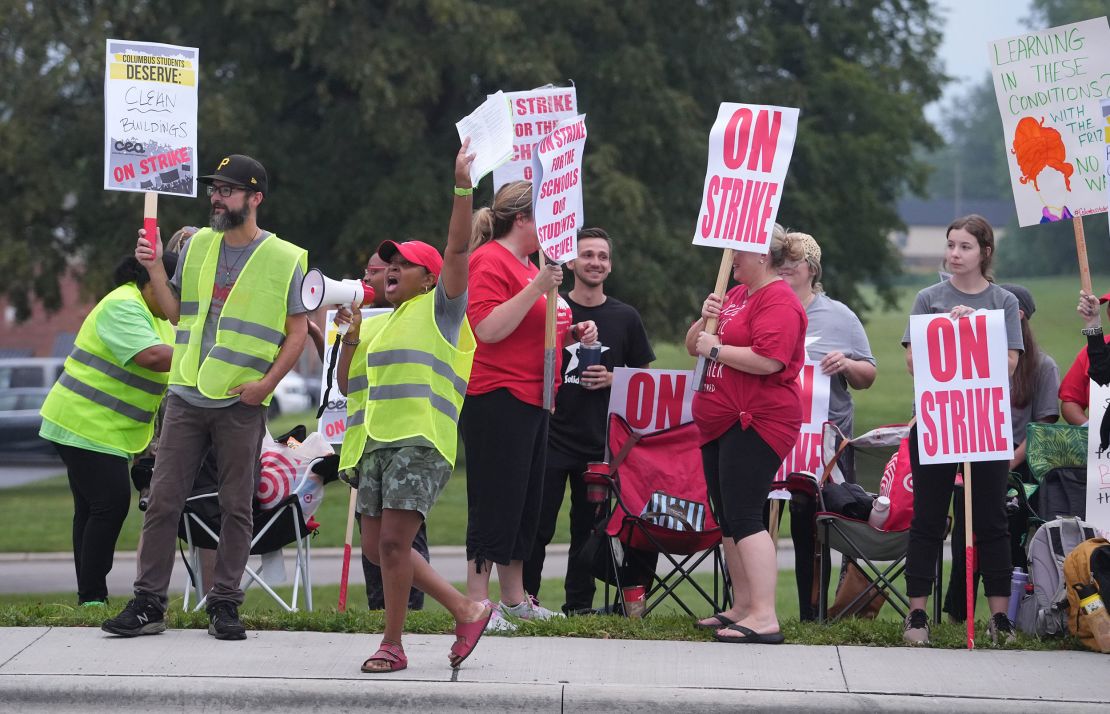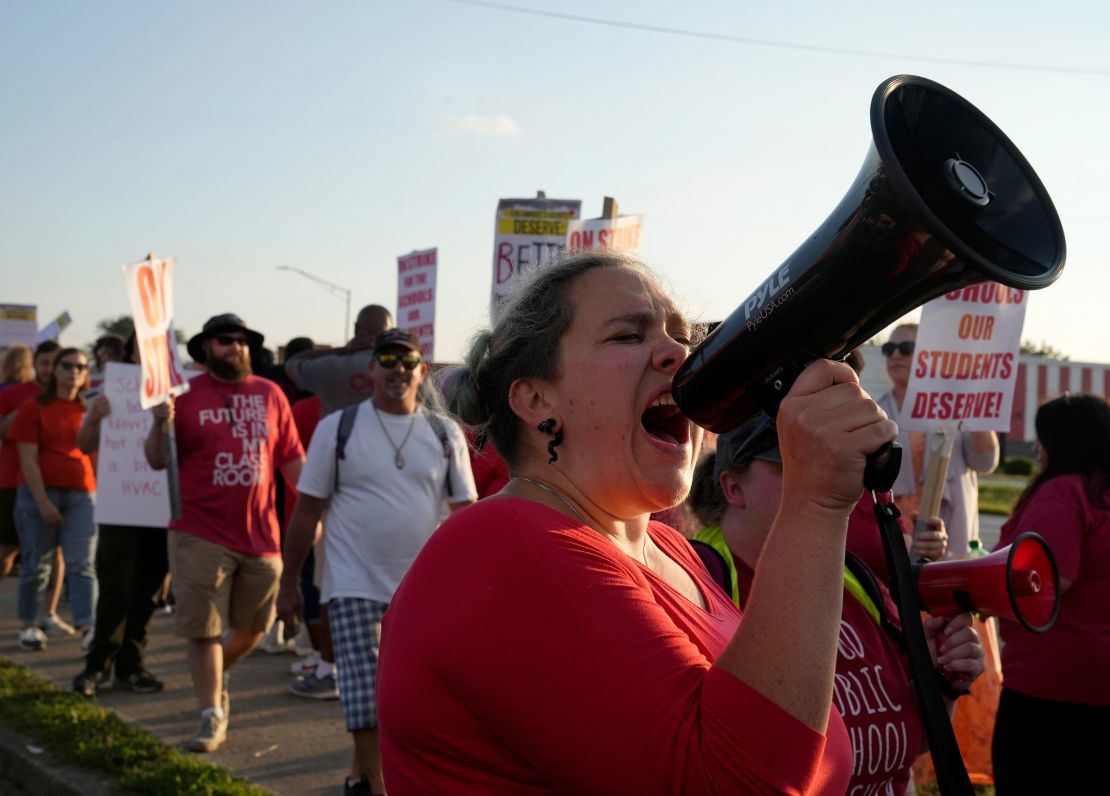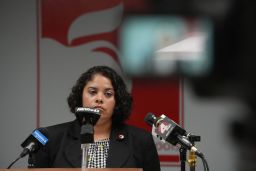The day before classes are scheduled to start, teachers in Ohio’s largest school system say they won’t end their strike without improvements to what they describe as dilapidated schools where a lack of heating and air conditioning has led to miserable classroom environments.
Union members in Columbus hit the picket line for a second day Tuesday, as the stalemate between the Columbus Education Association and the Columbus City Schools Board of Education continued.
The two sides are set to return to the bargaining table at 1 p.m. Wednesday, the afternoon of the first day of school, after a federal mediator overseeing negotiations called the union and Columbus City Schools to meet, the union said on its Facebook page. The school district confirmed that the meeting will take place on Twitter.
“The Columbus Board of Education remains focused on getting our students and teachers back in the classroom. The federal mediator has called both parties to resume bargaining on Wednesday, August 24. We will provide further updates as appropriate,” the district’s Twitter account said.
The showdown is the latest in years of tensions across the nation between teachers who argue they are underpaid and underappreciated, particularly after navigating the coronavirus pandemic, and school systems that say they are strapped for cash.
In Columbus, teachers say they want guarantees of smaller class sizes, full-time art, music and physical education teachers in elementary schools and a cap on the number of class periods throughout the school day.
But at the core of the strike is their complaint that too many schools, or parts of schools, lack heating and air conditioning, leaving students sweltering in the summer, shivering in the winter and distracted from learning.
“98 DEGREES IS A BOY BAND NOT A CLASSROOM TEMPERATURE,” read the sign one teacher held outside East High School – a reference to a pop group that was briefly popular in the late 1990s.

The strike began Monday after 94% of the union’s membership voted Sunday night to reject the board’s latest offer. If a deal isn’t struck late Tuesday, Columbus City Schools plans to begin its year with a return to early pandemic practices, having students log on remotely for classes led by substitutes. The district plans to distribute free lunches in grab-and-go containers. Sports and other extracurricular activities will be postponed.
Union members focused their protests on more than 20 schools where they would be visible from high-traffic streets or intersections. Passersby honked their horns in solidarity.
The union – with a membership of nearly 4,500 made up of mostly teachers, but also librarians, counselors, nurses and other school employees – had appointed captains to organize each picket location. Members protested in shifts: morning groups starting at 7 a.m., and afternoon groups that would remain out until 4:30 p.m.
Members and supporters delivered coolers of water and bags of snacks at several locations for those standing for hours on sidewalks on a sunny day with temperatures in the low 80s.
In front of East High School, one teacher was blaring classic rock protest songs from a speaker.
The union had instructed its members not to talk to reporters and to direct questions to their spokespeople. Instead, teachers pointed out nonunion members who were free to talk.
“A lot of people in the suburbs are unaware of how bad the conditions are, and I think they’re finally getting to see that,” said Maggy Counts, a former art teacher at East High School.
Counts, whose young twin boys will attend the district’s schools, said a teacher strike “has been a long time coming.”
She said she has heard promises to improve buildings and install heating and air conditioning systems for years, but that those improvements have never fully materialized.
It’s left teachers – who also complain that their pay is not keeping up with inflation and say they are dismally short on supplies – working in an environment that Counts described as burdensome for both educators and students.

“They should be able to come to a safe place where there’s not rats and roaches and hot conditions and little kindergartners in 58-degree weather,” Counts said.
“As an adult, if you go to work and it’s freezing or 98 degrees or you forgot your lunch, you’re not going to be a productive employee. And school is the same way,” she said. “We can’t have kids continuing to come to buildings and not have these basic needs, and we can’t expect teachers to come work in these conditions, either.”
Other protesters also said the board of education had delivered years of vague promises to improve schools’ conditions, but had not offered enough specific details on their plans or timelines to complete those improvements.
Columbus City Schools is using hundreds of millions in federal pandemic stimulus dollars to pay for HVAC systems in 16 schools. But six of the 13 schools that were initially planned to be ready by the start of this school year do not yet have working air conditioning.

“It’s 100% about the conditions of the schools,” said Lauren Chivington, a former Columbus City Schools teacher who is now an adjunct professor and PhD student and protested alongside union members at East High School on Tuesday.
“They haven’t gone on strike since the ’70s,” Chivington said of the union, which last went on strike in 1975. “They wouldn’t be doing this unless it were very, very dire, and very much about their students.”
While union members and their supporters nearly unanimously pointed to school conditions as the most significant reason for the strike, the two sides are also at odds over pay: Teachers had sought 8% annual pay increases, while the district’s most recent offer included 3% pay bumps each year.
On Monday night, the Columbus City Schools Board of Education met behind closed doors while hundreds of teachers’ union members protested outside.

“We want a contract, just and fair. Give our classrooms central air,” they chanted.
Jennifer Adair, the board of education president, released a statement after the four-hour meeting pledging that a path forward would come “soon.”
“We are working to find a collaborative path forward. We don’t have action on that to report yet. But we will – soon. Our board fully recognizes the disruption and concern felt by our children and families and across Columbus,” Adair said in the statement.
“To our school community, like you, we are saddened by this start to the school year,” she said. “Be assured we will support your children and families with the resources they need in this time of uncertainty.”





